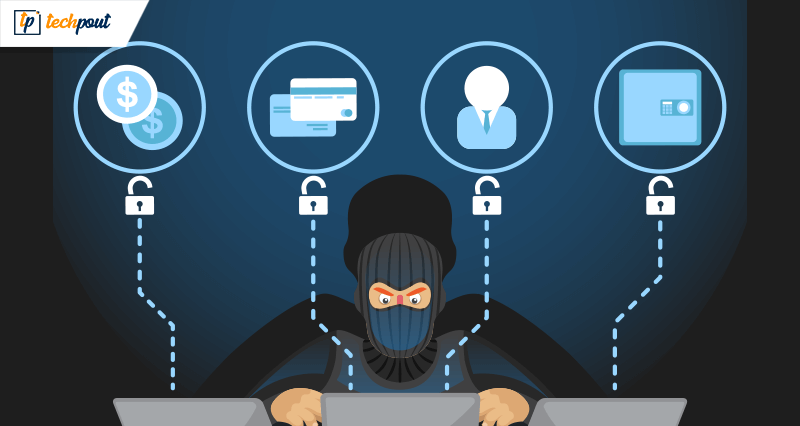Identity Theft: Definition, Stats & Protection

What is Identity Theft?
Identity theft happens when a thief uses a person’s identity or personal information and data- like name, Social Security number, identification card, and bank account details- without the person’s permission or knowledge.
Types of Identity Theft:
There are six basic categories of identity theft and countless other subcategories of those. We’ll limit this article to just the major types.
1. Account Takeover Fraud
It happens when someone uses a person’s account information to either extract funds or to purchase services and products, using existing accounts.
2. Medical Identity Theft
It happens when someone steals a person’s medical or health insurance data and obtains medical services or makes false claims.
3. Identity Cloning
It happens when someone steals the complete identity of a person and starts to live and function like that person.
4. New Account Fraud
It happens when someone uses a person’s personal identifying information to purchase services and products using the person’s good credit.
5. Business or Commercial Identity Theft
It happens when someone uses a business’ name to obtain credit and details of clients for services and products.
6. Criminal Identity Theft
It happens when someone commits a crime using another person’s identity and name.
Read Also: 9 Cyber Security Threats to Small Businesses in 2019
Some Startling and Staggering Identity Theft Statistics:
Because sometimes you just need the help of hard, cold, and scary facts to engrave and emphasize the depth of the situation.
- In the United States, someone falls victim to identity theft every two seconds. That means by the time you swipe right (or left) on a dating application, you, my friend, would be bereft of your identity.
- Unfortunately, Americans are more likely to be the victims of identity theft than any other nationalities. In 2016, over 790 million identities were stolen in the US alone. That’s a lot.
- In the US, identity theft is one of the biggest crime prevention issues. It makes up about 13% of all criminal complaints (recorded).
- The total yearly cost of identity theft is *drum rolls*, more than $16 billion *mind blown*.
- About 1.3 million children get their identities stolen every year. The statistics show that the majority of these children are not above the age of six. It is because they have blank credit files, and the fraud takes long to be detected. But the impact is serious and sickening, once they grow older.
Some Examples of Identity Theft:
Identity theft happens in multiples of different ways. These federal thieves don’t have a set pattern of stealing and using the personal information of the victims. But there’s one thing for sure; it’s that the effect of these crimes is distressing and far too long for the victims.
These identity theft examples portray a similar scenario:
1. Celebrity ID fraud
This happened with Abraham Abdallah in 2001. He was arrested because he had taken on the identities of a few very wealthy American executives and celebrities. He gained access to bank accounts, credit cards, and much more.
2. Wi-Fi Fraud
In 2009, Lara Love and David Jackson stole private information like credit card numbers through Wi-Fi networks of their neighbors.
3. Faking a social identity:
In this, Rebecca Nakutis found that someone else was using her pictures and data to create a fake social media profile that used her data and pictures to create a fake profile.
Warning Signs of Identity Theft:
If you take out 5 minutes from your busy life, term these small changes as serious, and follow-up on them, then you’ll save yourself from a lot of trouble and pain in the future. Acting on something as soon as possible is always the best move.
- You see bills for the goods or services you didn’t purchase on your bank statements.
- You receive statements for unknown credit card accounts.
- You find that there is a stoppage of mails or emails from your bank or credit card company.
- You receive collection calls or notices for a debt you don’t even owe.
- You have been denied an application for credit even though you have good credit.
- You find a lot (or small amount) of errors on your credit reports.
How Does Identity Theft Happen?
Identity thieves are masters at stealing personal information and data. Throughout the years, their methods have gotten better and more sophisticated. But still, there’s always a leeway of error provided to them by us. This is how identity theft takes place:
- They steal purses or wallets, which contain personal information like identification documents, credit, and bank cards.
- They obtain personnel records and data from the victim’s place of employment, social media, a third-party source, or through the internet activities (unsecured websites or public Wi-Fi) of the victim.
- They dig through trash, “dumpster diving”, to gain access to discarded personal data.
- They even “skim” information from an ATM, by using an electronic device that is attached to the ATM and steals data stored on a debit or credit card’s magnetic strip.
- They rummage through the mail, online and offline, to look for and steal phone or utility bills, tax information, credit, and bank statements, and other such data.
- They “phish” for personal electronic data with phony text messages, emails, calls, and websites that are exclusively designed to steal sensitive information.
- They steal the maximum records during a company-wide data breach.
Steps to Take When You Believe that You are a Victim of Identity Theft:
Identity theft can be highly damaging, and sometimes you don’t even realize that your identity has been stolen. But once you do get to know about it, you shouldn’t sit idle worrying but rather take some immediate steps to curb the exponentially growing damage.
Step 1: Notify and inform the affected banks or creditors.
Step 2: Check and put a fraud alert and/or freeze your credit reports.
Step 3: Report the theft to the Federal Trade Commission (FTC) or the respective theft officials.
Step 4: Contact and file a report to your local police department.
Step 5: Remove all the fraudulent information from your credit reports.
Step 6: Change all the passwords of the accounts affected and tighten security on them.
Step 7: Replace and create your new identification, which was stolen.
Step 8: Open new financial and credit card accounts.
Step 9: Finally, don’t take stress about it, and from here on keep taking check of your account actions. Opt for an identity theft protection service, if you’d like.
Identity Theft Prevention:
There’s bad news; you can’t completely protect yourself from identity theft. But you can greatly reduce the risk of it happening to you, by following these steps:
- Guard your government-issued identity or income tracking cards, like Social Security number. Always keep them locked up, and memorize the credentials on them. Take them out, only when it’s necessary.
- Be very cautious in public, especially in crowded places. Identity thieves are very creative; they can be listening or noticing your private conversations.
- Always password-protect all your gadgets, including computers and phones. Also, put passwords on and protect your sensitive information like account details, bank information, and other such data.
- Keep a check on your trash as well. Imbibe a habit of shredding all your documents containing important information and then dumping them.
- Be wary of the bogus and ‘phishy’ emails, calls, and text messages you get. Don’t click on any links that might seem dishonest and not secure.
- Always keep a check on your credit reports.
Identity Theft Protection Services:
Sometimes the basic preventive steps don’t hit the mark, and you feel the need for something extra. This is when Identity theft protection services come into the picture. They help in monitoring and protecting a person’s identity. They also help out in recovering when a person experiences identity theft. They usually begin with credit monitoring and layer on additional services to alert about budding problems.
Some of the most favored and the top Identity theft protection services are LifeLock, IdentityForce, Identity Guard, and Complete ID.
Final words:
Identity theft is a scary thing to happen to anyone. It puts you in an unending fearful and difficult position, and you feel that you won’t be able to get out of it.
But there is nothing to be worried about. Just follow all the precautions and steps above, and learn from the previously happened identity theft examples on what to do and what not to do.



Like!! Really appreciate you sharing this blog post.Really thank you! Keep writing.